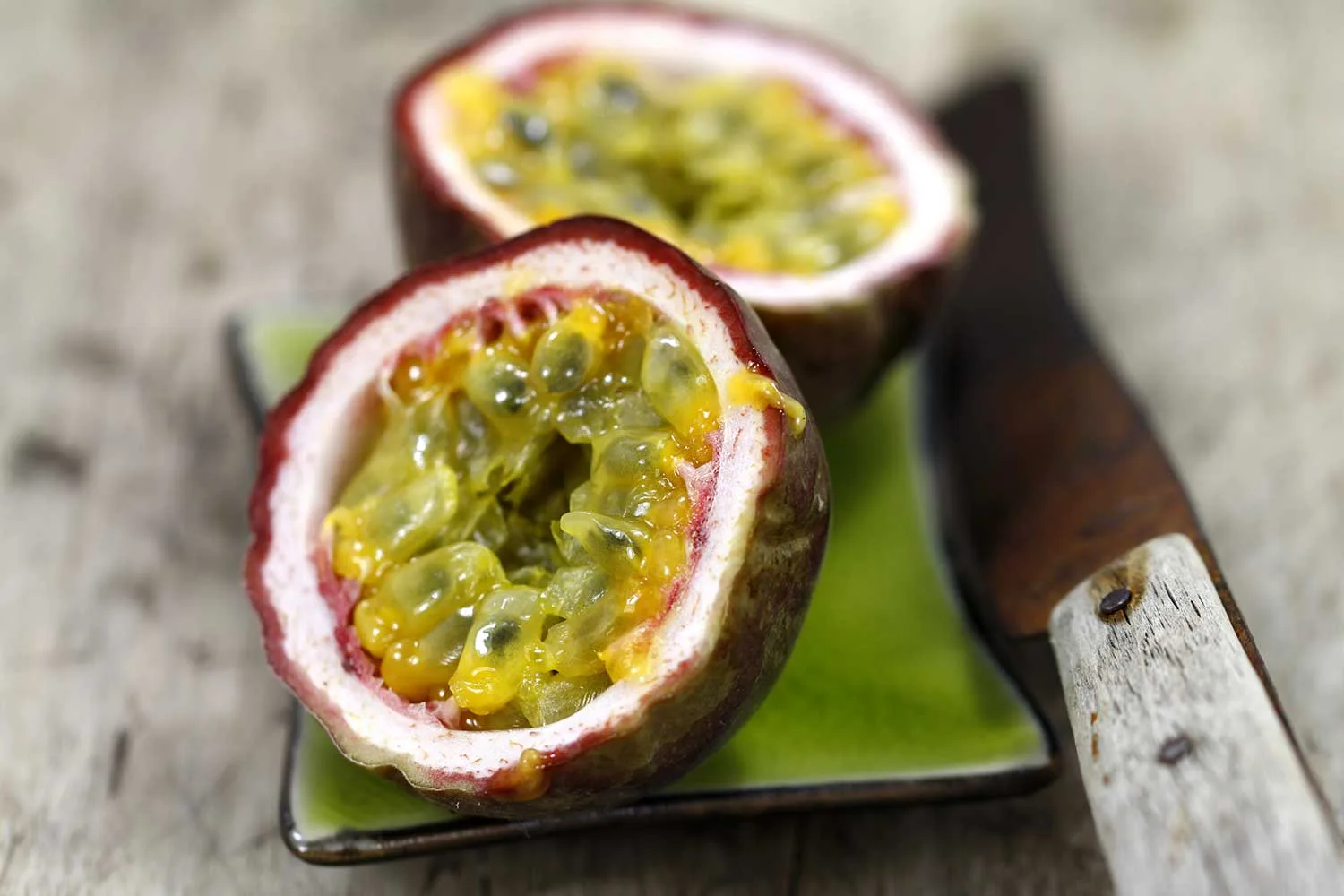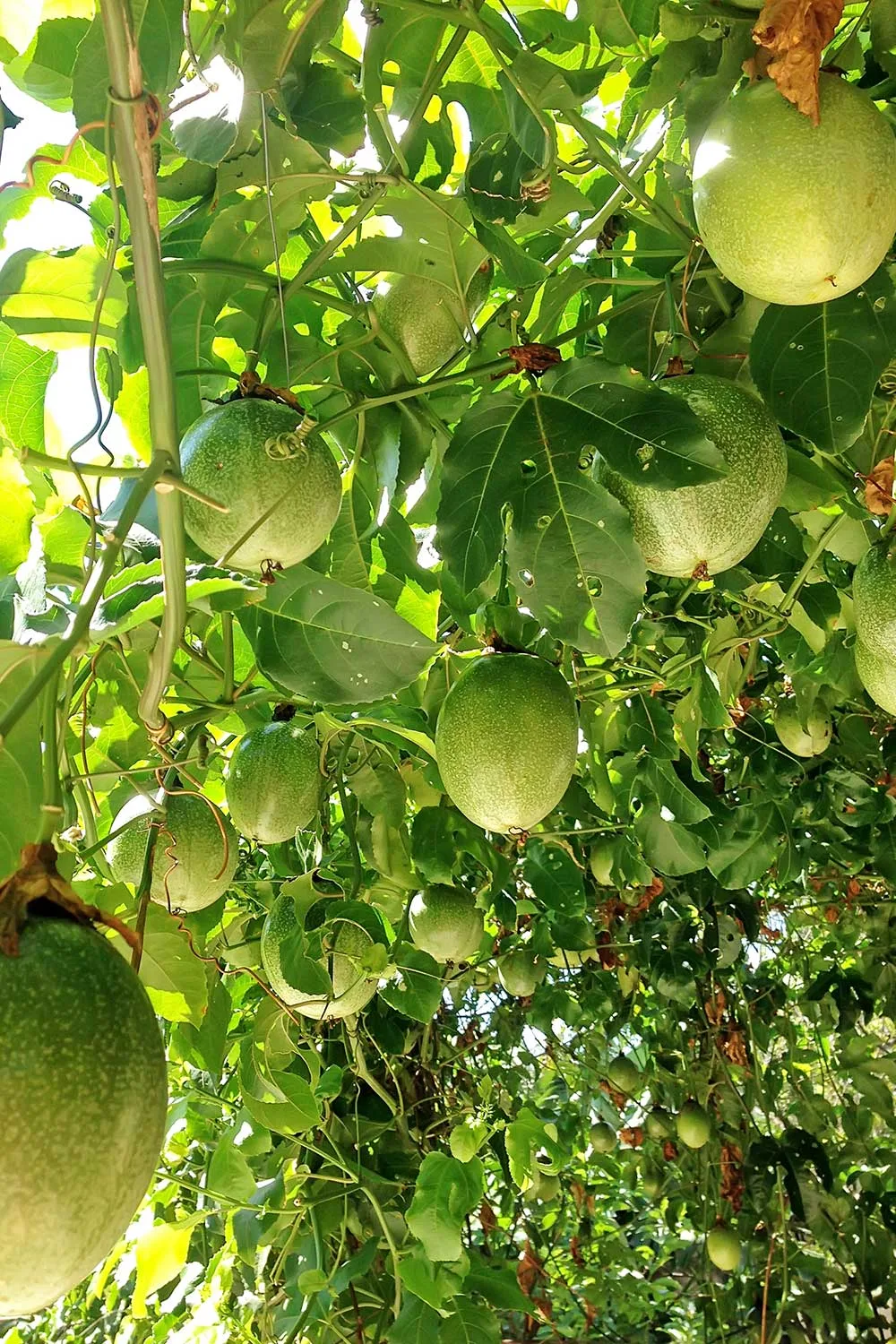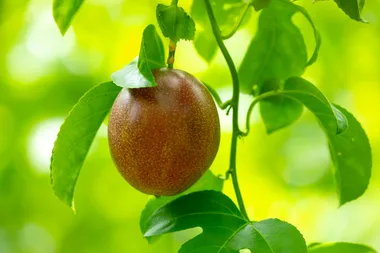Passion fruit vines are an incredible plant to grow in any garden. Not only do they produce mouth-wateringly delicious fruit, their vine can also serve as a stunning camouflage over unsightly walls and fences.
So, here’s how to grow passionfruit in your backyard plus essential tips for vine care.
Growing passionfruit at a glance
- When to plant: spring to autumn.
- Climate: subtropical and temperate.
- Aspect: full sun with protection from wind.
- Water: on a regular basis.
- Soil type: rich in organic matter.
- Blooms/Harvest: flowers – mid-spring, fruit – early summer.
Passionfruit varieties
There are over 50 varieties of passionfruit vine, including Banana, Hawaiian, Norfolk Island, Yellow Giant, Panama Gold, Panama Red and Nellie Kelly.
Cultivars can differ in cold tolerance, so always check the label before buying. The kind you’ll most commonly find in Aussie backyards is the Nellie Kelly – a cultivar bred to withstand cooler temperatures and resist pests and diseases. In more tropical regions, Panamas grow best.

How to care for passionfruit
Climate
Passionfruit vines are versatile but are best suited to subtropical and temperate climates, provided there is protection from frost when young.
Aspect
Position your passionfruit vine in full sun with protection from strong winds. In colder climates, choose a spot in front of a north-facing wall to utilise to radiated heat.
Passionfruit vines grow extensive root systems so ensure the spot you choose to plant has plenty of space, free from weeds, competing plants and grass. They will also spread up to 10 metres squared so choose or build a structure that can accommodate it.
Passionfruit vines can also be trained to grow along your fence, on a wooden or wire trellis, or over an arbour. Just install some wire or mesh to support its tendrils.
Soil
The best soil for passionfruit vines is rich in organic matter and well-drained with a pH of 5.5 to 6.5.

Planting
Spring is best time to plant a passionfruit vine. Before planting, prepare your soil by incorporating compost and chicken manure to an area around one to two metres wide. Dig a hole twice as wide and just as deep as the root ball, gently tease the roots, plant the vine and water well. Mulch around the base with sugarcane, bark chips or pea straw, but don’t let it build up around the stem.
Passionfruit vines can also be grown in large pots as long as they have an adequate support structure.
Watering
Passionfruit vines require regular watering, especially when the vine is young and when it’s flowering and fruiting. Water deeply a couple of times a week, depending on weather conditions and climate.
Remember to spread your watering over the entire root system, not just around the stem of the vine.

Fertilising
Feed your passionfruit vine with well-watered-in citrus food or a chicken manure twice a year, in spring and autumn. Ensure you spread the fertiliser over the entire root system. Avoid over-feeding or using fertilisers that are high in nitrogen, this will encourage leaf growth at the expense of flowers and fruits.
Harvesting
Flowers usually appear in mid-spring before fruiting in early summer. Your first fruit will appear around six to eight months after planting but have patience – it can take around 18 months for a passionfruit vine to fruit.
Passionfruits need to fully ripen on the vine and will drop off when they’re ready to eat. They can also be picked off the vine when their colour is fully developed and come away from the vine easily.

Pruning
The best time to prune a passionfruit vine is in late winter or early spring. Cutting the vine back by about a third will encourage vigorous growth and more fruit.
Propagation
The passionfruit vine can be propagated from cuttings but is best grown from seed.
How to grow passionfruit
- Step 1: Choose a spot in the garden that has full sun (around 6 hours) that is also protected from harsh winds.
- Step 2: Passionfruit vines need support, so you must place your vine with a trellis, near a fence, wall or pergola. It will need up to 2m of space.
- Step 3: Make sure your soil is rich in organic matter. If it needs extra nutrients, use compost, manure or blood and bone.
- Step 4: Dig a hole at the same depth and double the width of your potted vine. Position in hole and backfill with soil. Form a raised doughnut-shaped soil ring, around 20cm away from the base of the stem (this is to ensure water can stay with the plant for longer).
- Step 5: Water well. Keep the soil moist for a few weeks after planting to help the vine establish properly.
- Step 6: Apply a layer of mulch, preferably organic, around the base of your passionfruit plant.

Passionfruit vine problems
Not fruiting
A common complaint of passionfruit growers is a lack of fruit. There are a number of factors that could be to blame, but poor pollination is the most common.
The essential work of bees can be impacted by changes in weather such as consistent, heavy rain, and fluctuating temperatures. Over-fertilisation can also cause your vine to grow but without flowers and fruit.
Fruit dropping
If your passionfruit is fruiting but the goods are dropping off the vine, it could be due to irregular watering, fungal diseases or fruit flies.
Yellow leaves
Wondering why your passionfruit leaves are going yellow? The most common cause is woodiness virus, but it could also be down to magnesium or nitrogen deficiency, or “winter yellows” brought on by cold, windy weather.
Spots
If you’re noticing spots on your vine’s leaves and fruit, it’s most likely due to fungal diseases such as alternata spot or brown spot.
Do you need two passionfruit trees to produce fruit?
No, you do not necessarily need two passionfruit trees to produce fruit. Passionfruit is generally a self-pollinating plant, which means a single tree can pollinate itself and produce fruit. However, having multiple trees can increase the chances of successful pollination and potentially result in higher fruit yields.
If you have limited space or resources, you can still grow a single passionfruit tree and expect it to produce fruit.



